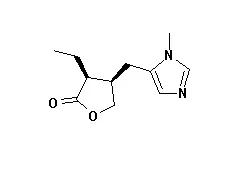| Animal Research: |
| Epilepsy Research, 2002, 49(2):109-120. | | Pilocarpine-induced status epilepticus results in mossy fiber sprouting and spontaneous seizures in C57BL/6 and CD-1 mice[Reference: WebLink] | Several rodent models are available to study the cellular mechanisms associated with the development of temporal lobe epilepsy (TLE), but few have been successfully transferred to inbred mouse strains commonly used in genetic mutation studies.
METHODS AND RESULTS:
We examined spontaneous seizure development and correlative axon sprouting in the dentate gyrus of CD-1 and C57BL/6 mice after systemic injection of Pilocarpine. Pilocarpine induced seizures and status epilepticus (SE) after systemic injection in both strains, although SE onset latency was greater for C57BL/6 mice. There were also animals of both strains which did not experience SE after Pilocarpine treatment. After a period of normal behavior for several days after the Pilocarpine treatment, spontaneous tonic–clonic seizures were observed in most CD-1 mice and all C57BL/6 that survived Pilocarpine-induced SE. Robust mossy fiber sprouting into the inner molecular layer was observed after 4–8 weeks in mice from both strains which had experienced SE, and cell loss was apparent in the hippocampus. Mossy fiber sprouting and spontaneous seizures were not observed in mice that did not experience a period of SE.
CONCLUSIONS:
These results indicate that Pilocarpine induces spontaneous seizures and mossy fiber sprouting in both CD-1 and C57BL/6 mouse strains. Unlike systemic kainic acid treatment, the Pilocarpine model offers a potentially useful tool for studying TLE development in genetically modified mice raised on the C57BL/6 background. |
|
| Structure Identification: |
| Current Pharmaceutical Analysis,2016,12(4):315-324. | | Development and Validation of a New Method to Quantify Pilocarpine in Tablets by Hplc-Dad.[Reference: WebLink] | Pilocarpine, a natural alkaloid that can be obtained from species of Pilocarpus, has been used to treat glaucoma, ocular hypertension and xerostomia. The development and validation methods for analysis of Pilocarpine and its degradation products are quite challenging since the physicochemical properties between them are relative small.
METHODS AND RESULTS:
Analytical tests in HPLC-DAD were performed and 13 different conditions were take into acount, employing three columns (silica based C18, modified-silica cyanopropyl and Zic-HILIC), two buffer solutions, two organic solvents, pH ranging from 5.1 to 5.45, three temperatures and flow rate from 0.8 to 2.0 mL.min⁻¹, in RP or HILIC. The chromatographic assays for Pilocarpine hydrochloride in aqueous solution allowed to establish the best chromatographic parameters in terms of signal symmetry and retention as well as to separate Pilocarpine from its degradation products with great selectivity, efficiency and resolution. It was possible to validate a new method to dosage Pilocarpine hydrochloride in tablets using a modified-silica cyanopropyl column, mobile phase in isocratic mode with mixture of acetonitrile/ potassium dihydrogen phosphate buffer 10 mM (60:40, v/v), pH 5.30, oven temperature of 50 oC and flow rate of 1.0 mL.min⁻¹. The precision, accuracy, linearity, robustness, recovery, short retention time, isocratic elution mode, quantification (250 ng.mL⁻¹) and identification (75 ng.mL⁻¹) limits allowed establishing a routine estimation for Pilocarpine in tablets.
CONCLUSIONS:
The Pilocarpine hydrochloride content it was in the range as specified by the Salagen® producer (4.81 ± 0.07 mg/ tablet, 96.16 ± 1.33%) and by the formulation in carbomer 940® + chitosan tablets (4.80 ± 0.02 mg/ tablet, 95.99 ± 0.49%) and in sodium carboxymethylcellulose + chitosan tablets (4.95 ± 0.04 mg/ tablet, 99.08 ± 0.79%). | | Journal of Korean society of Dental Hygiene,2013,13(3):517-523. | | Antimicrobial activity of jaborandi extract and sorbitol to oral microbes.[Reference: WebLink] | The aim of the study is to investigate the antimicrobial activity of jaborandi and sorbitol to various oral microbes.
METHODS AND RESULTS:
Jaborandi leaves contain Pilocarpine. The conditions for extraction were optimized on the basis of substances, temperatures and pHs. Total Pilocarpine content after extraction was analyzed by HPLC. The herbal antimicrobial activity of jaborandi and sorbitol were evaluated for oral microbes containing ATCC 25175 S. mutans, ATCC 13419 S. salivarius, ATCC 6249 S. mitis, ATCC 33398 S. equi, ATCC 29213 S. aureus, ATCC 14053 C. albicans. The optimum conditions for highest yielding extraction were Pilocarpine content after boiling at for 1 hour at pH 3. The level of total Pilocarpine content was analyzed at 833 mg/kg by HPLC. The most effective antimicrobial activity was obtained by combination of Pilocarpine and sorbitol rather than Pilocarpine, menthol and sorbitol, respectively.
CONCLUSIONS:
This results supported the preventive oral health care using safe and convenient jaborandi herb. |
|






 Cell. 2018 Jan 11;172(1-2):249-261.e12. doi: 10.1016/j.cell.2017.12.019.IF=36.216(2019)
Cell. 2018 Jan 11;172(1-2):249-261.e12. doi: 10.1016/j.cell.2017.12.019.IF=36.216(2019) Cell Metab. 2020 Mar 3;31(3):534-548.e5. doi: 10.1016/j.cmet.2020.01.002.IF=22.415(2019)
Cell Metab. 2020 Mar 3;31(3):534-548.e5. doi: 10.1016/j.cmet.2020.01.002.IF=22.415(2019) Mol Cell. 2017 Nov 16;68(4):673-685.e6. doi: 10.1016/j.molcel.2017.10.022.IF=14.548(2019)
Mol Cell. 2017 Nov 16;68(4):673-685.e6. doi: 10.1016/j.molcel.2017.10.022.IF=14.548(2019)